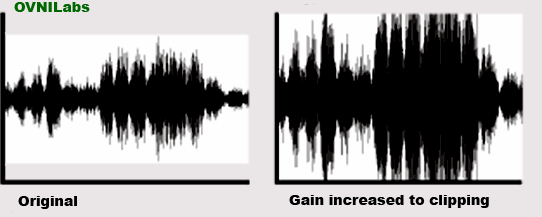Extensive compressor reviews and FAQ


Distortion, Clipping, and Square Waves:
These three terms can be quite confusing--partly because people mix them up all the time, and partly because they can in fact overlap in meaning. "Distortion" also has multiple correct meanings.
Clipping has a very specific meaning: every audio device, from a transistor to a tube to a speaker, has a maximum limit of how high of a signal can pass through cleanly; when the level of signal going through exceeds that maximum, the tops of the waves get clipped off (flattened out). Imagine a doorway of average height--a short man walks through easily, and a medium-height man walks through easily, but a very tall man knocks his head against the top of the door frame. The impact of the tall man's head is the distortion that results when your signal's peak level is too high for the device it is trying to pass through. Here is an idealized illustration, using a sine wave:

Clipping like that results in compression of the signal, and compression in general is a type of soft clipping. You can think of compression as being like the tall man ducking down as he walks through the doorway, to avoid hitting his head.
From a technical standpoint, distortion means any change in the wave-shape of a signal from the input of a device to the output. So even a simple change in tone, without clipping, can be accurately called distortion. Here is an example:

Changes in amplitude (volume) don't necessarily change the wave shape, so turning the signal up or down is not distortion. Even though clipping is just one type of distortion, for at least six decades guitarists have used the word distortion to mean clipping of their amp, at any stage: the preamp, power section, or speaker. It also is very commonly used to mean a pedal effect that emulates an amp pushed to clipping, especially at a level of clipping that is more intense than "overdrive" but not quite as extreme as "fuzz". Since that type of meaning is so commonly used and understood, it can sometimes be tricky for engineers and guitarists to communicate.
Some distortion effects are created by using square waves. All sound travels in waves of various shapes, and a square wave is a particular wave shape (the pink one here):

This shape comes from adding odd-integer harmonics to a sine wave; the more harmonics are added, the closer to a square shape it becomes. As you can see from the first image in this article, a clipped sine wave can look kind of like a square wave. Because of this, many people get the idea that clipping their amp results in square waves--but this is almost always false. Amplified audio waves are almost never perfect sine waves, due to phase alterations caused by the amplifier and speakers; and even with a perfect sine wave it takes an extreme amount of clipping to start to resemble a square wave. Here is what clipped audio really looks like, in almost all cases:

No squares there. The reason I point this out is because many people think square waves will burn out their speakers--but even in the rare cases where the clipped wave does sort of resemble a square, if square waves really damaged speakers then how would we ever be able to listen to a recording of a synthesizer or a pipe organ? The "overheating piston" action that people claim occurs with a square wave simply does not happen in reality, at least not to any degree more than other big signal peaks; and again in reality clipping audio doesn't result in square waves anyway. The burnt-out coils that amp repair techs regularly deal with all resulted from too much power being sent into the speaker, completely regardless of whatever wave shapes were sent through it. You will hear lots of people--even senior audio professionals--recite the claim that clipping and square waves damage speakers as if it was "gospel truth", but it's really just a long-established myth that will not die. Here's how that myth got started, and maybe why it continues:
When you crank an amplifier to its maximum, and feed it a strong, spiky input signal, it can actually put out much more power than it is rated for--sometimes hundreds of watts more. So for example when a bassist has a 200 W amplifier, and a speaker cab rated for 300 W, he might suppose that there's no way the amp could overpower the speakers; but if he dimes the amp's output, and plays aggressively, he certainly could blow those speakers, because he will be sending spikes much higher than 300 W into that cab, all night long. Yes, the amp will have been clipping like crazy, so he (and his amp repair tech) will usually assume it was the clipping that blew the cones--but it was the excess power that actually did the damage. On top of all that, tweeters (high-frequency drivers) are usually rated for a lot less power handling ability than larger speakers are; and the harmonics of clipped waves can mean a lot of extra energy up in the high frequency ranges that typically get sent into a tweeter; so it's fairly common for clipping at high volume to result in way too much power being sent into the tweeter, causing it to burn out. Just remember that the same wave shape, at a lower volume level, would not have done any harm.

nothing to see here
All text on this page written and owned by Cyrus Joaquin Heiduska, 2006-2024, all rights reserved.
Copying is prohibited, and AI scraping or training is prohibited. Instead, please link to this page using the link text "compressor reviews".
PRIVACY POLICY